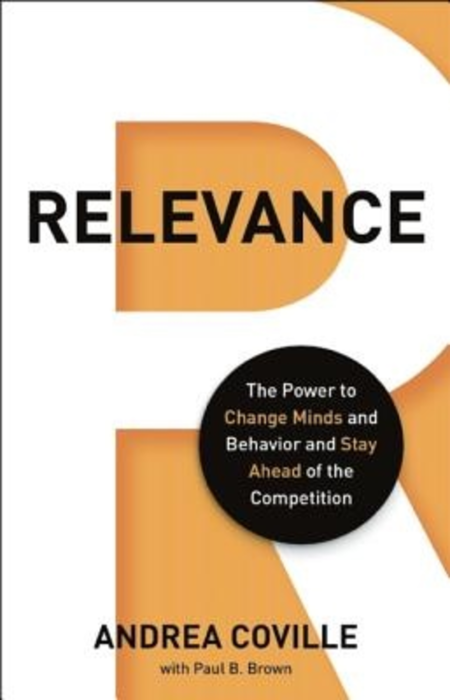Many marketers struggle when it comes to innovation. A few tech start-ups managed to obliterate the status quo almost overnight, and marketers have been trying to keep up ever since–but to some of those marketers, it’s not clear why consumers have taken so well to these new companies. Companies like Amazon, Facebook, and Google. Simply put, it’s because those companies know their customers. They understand them. They are relevant to them.
Brodeur Partners CEO Andrea Coville teamed up with long-time New York Times contributor Paul B. Brown to address relevance as a marketing concept in their forthcoming book Relevance: The Power to Change Minds and Behavior and Stay Ahead of the Competition. Here, they discuss the concept of relevance marketing and why relevance is the key to innovation.
Why should marketers care about being relevant?
Coville: Marketers are famous for being incredible about using data. The idea of relevance is that it goes beyond just the data; the data is a part of a more holistic experience. Other things like values, the sensory side of an experience, the community, are important, as well.
[But] marketers struggle with creating long-lasting creative concepts—ones that stay popular outside of the traditional campaign. So much of our thinking is around annual campaigns. What I’ve seen missing…[is] connecting marketing communications more directly to behavioral change. To do that your marketing has to be relevant enough to…gain an individual’s attention.Brown: Relevance is something useful that will make your life better, something you use to forge a relationship as a marketer with your customers, or people you’d like to become your customers; people who’s behavior you’d like to change. If you think about direct marketers, this is exactly what they do. They have something useful, they communicate it in a way that resonates, and they solve problems.
You mentioned, Andrea, that marketers are famous for their love for data and analytics. How can marketers measure relevance?
Brown: What we argue in the book that any marketing communication at all that doesn’t boost sales is a waste of time. So, if you implement a relevant campaign you should be able to see a rise in metrics that are important to you. If repeat visits are important to you, after the relevance campaign, you should see a rise in repeat visits. If it’s reaching millennials, you should be able to see that you are.
Coville: This is the area of our research that we’re focusing on right now. Yes, there is a return on relevance. We believe that the more relevant you are, the better chance you have of capturing new customers, and once you do, retaining that customer over a longer period of time. It goes back to the classic customer value chain where you get far more profit from a long-term customer.
What exactly is a “relevance campaign” then? What are some examples of relevant campaigns?
Coville: A relevance process starts as a strategic planning process [that includes] some form of qualitative and quantitative research.
Brown: If you want a bad [relevance campaign] then you’ll go…in and say, “I know what’s relevant to my customers. I know everything there is to know about every part of my customer.” That’s just stupid. And yet, you’ll hear marketers say this, and then they’ll outline what’s relevant to them. That’s lovely if they’re selling to people exactly like them, but most people aren’t like them. By doing both the quantitative stuff and then the four pillars [of community, sensory, thinking, and values] you get a deeper understanding of what’s relevant not only to people like you, but to everybody else.
Coville: A great example of sensory relevancy is what Apple’s done to revolutionize the sensory elements of smartphones via the touch screen.
How about relevance for B2B marketers?
Coville: [One] example is what we did with a client. They had just came up with something they coined Gorilla Glass. This protective coating is now on most of the smartphones on the market. At the beginning they wanted to make their product relevant to both consumers and businesses.
Using research, we worked with an advertising firm on a series called “A Day Made of Glass.” It was based on insight and data and the content was so relevant to consumers that it set a record for YouTube views in a B2B category.
Relevancy can work anywhere, in any market.
You mention in the book that innovation and relevance are hopelessly intertwined. What did you mean?
Brown: One of the things that happen when your company is stuck with innovation is your boss will come in and say, “If money were no object, if gravity didn’t exist, what would you do?”
The problem with that is that money is always an object. Gravity will always exist. If you make relevance part of the innovation process it becomes a way to check yourself at every step of the process. There’s pressure on every company to innovate. But if you come up with new ideas that don’t make money then you’ve wasted time or created a hobby. You have to check that you’re creating something useful that resonates with people.








